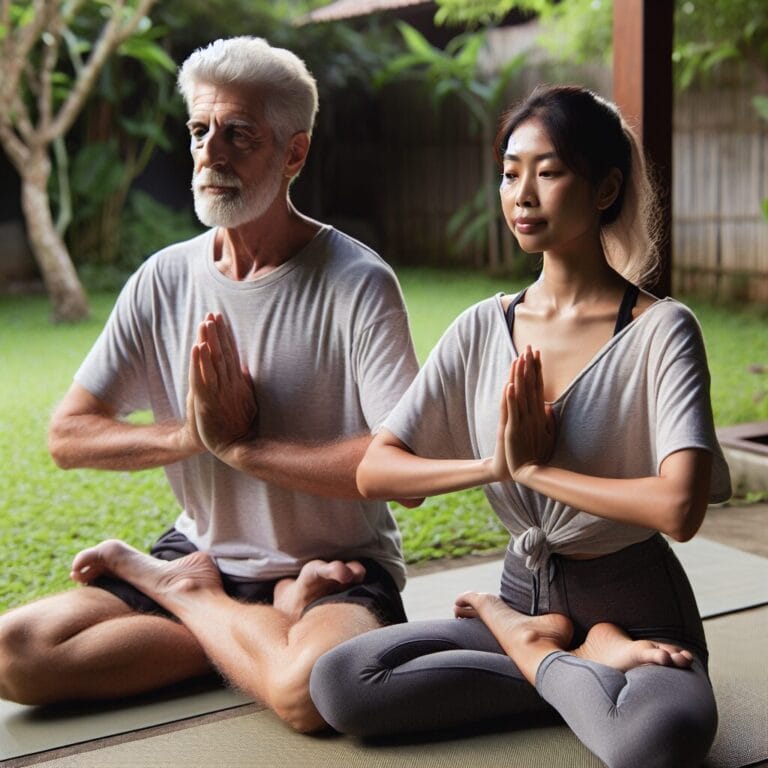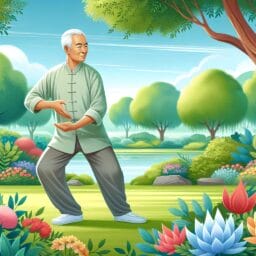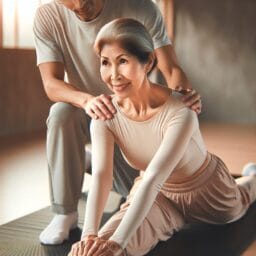
Sleep Better Tonight: Exercise Tips for Elderly to Enhance Rest
Table of Contents
- Introduction
- Understanding Sleep Patterns in the Elderly
- Safe Exercise Tips for the Elderly
- Best Types of Exercise for Improving Sleep
- Creating an Exercise Schedule That Promotes Better Sleep
- Additional Tips for Better Sleep
- Conclusion
- Frequently Asked Questions
Introduction
Guess what? When older folks put on their sneakers and get moving, something pretty cool happens—they often wave goodbye to those pesky sheep they’ve been counting all night! You see, scientists have found a nifty link between wiggling and jiggling during the day and snoozing like a baby at night. For the golden-agers in our lives, getting enough zzz’s is like having a superpower—it helps them think sharper, stay happier, and even ties their shoes faster. Okay, maybe not that last one, but good sleep sure makes life better!
Now let’s talk turkey about exercise. Did you know that certain types of physical activities can perform magic tricks on your body clock? Yep! Things like aerobic exercise (that’s stuff like walking fast or swimming) can shake up your circadian rhythms—that’s a fancy word for the body’s internal clock—and help you fall asleep quicker than you can say “sweet dreams.” And there’s more: exercises such as tai chi have this soothing effect that could make Mr. Sandman visit seniors more often.
But hold up—before gramps starts prepping for a marathon or granny considers bench pressing, let’s aim for moderate exercise. We’re talking about a nice stroll in the park or some stretches while watching TV because these kinds of moves are just right for better shut-eye without overdoing it.
For the community-dwelling older adults—folks who live in their homes or with family—not only does regular huffing-and-puffing mean fewer sleep problems, but it also gives them more deep sleep time. That deep sleep is top-notch stuff; it’s when the body repairs itself and gets fit as a fiddle for another day of fun adventures.
What about those elders who sometimes reach for sleeping pills? Well, swapping some of those pills with sneakers might be worth chatting about with their doctor because too many pills aren’t always the bee’s knees.
So next time we chat with our senior pals about catching more winks at night, let’s remind them (just once – promise!) to throw in a little groove and move during the day. It could mean sweeter dreams and brighter days ahead. Now isn’t that something to dance about before bedtime?
Understanding Sleep Patterns in the Elderly
Did you know that as we age, our sleep architecture—that’s the fancy term for how we cycle through different stages of sleep—goes through a bit of a renovation? It’s true! Older adults tend to spend less time in that rejuvenating deep sleep and more time in the lighter stages. This can mean they wake up feeling like they haven’t quite hit the recharge button.
Now, here’s where lacing up those walking shoes comes into play. Regular physical activity has been shown to not only increase the amount of deep sleep older adults get but also help them fall asleep faster and wake up less during the night. Think of exercise as nature’s sleep medicine; it helps realign those circadian rhythms so seniors are catching more Zs when nighttime rolls around.
But wait, there’s more good news about moving and shaking! Exercise doesn’t just affect sleep quality; it also cranks up body temperature for a bit. Afterward, as body temperature gently falls back down, this decrease actually promotes sleep onset – that’s science talk for making it easier to drift off to dreamland.
Let’s not forget that some common gremlins messing with senior slumber are pesky sleep disorders like insomnia or sleep apnea. Regular moderate exercise can be an ally in battling these intruders by reducing insomnia symptoms and improving overall well-being. Next thing you know, tossing and turning could be replaced with sweet dreams and good night’s sleep!
To wrap this little chat in a cozy blanket, imagine community-dwelling older adults weaving exercise into their day-to-day lives—it might look like a joyful tai chi session in the park or perhaps a heart-pumping water aerobics class at the local pool. Such physical activities not only spice up their daily routine but work behind the scenes to smooth out those bothersome sleep disturbances.
In summary, every step taken is a step toward better rest! So while sleeping pills may sometimes appear to be a quick fix, regular doses of aerobic exercise could be one ticket to consistently peaceful nights without pill bottles on the nightstand. Remember: A good day starts with good habits forged the day before—and for our seasoned friends aiming for amazing tomorrows, those habits surely include staying active today!
Safe Exercise Tips for the Elderly
Imagine this: you’re flipping through the pages of your photo album, and there’s Grandpa Joe back in his heyday, flexing muscles and chasing frisbees like a spring chicken. Now, while Grandpa might not be snagging flying discs these days, he’s got a new game plan for keeping spry—low-impact exercises! These gentle moves are just the ticket for seniors who want to boogie their way to better slumber without the worry of achy-breaky joints.
Before our golden oldies kickstart any physical shenanigans though, let’s make sure they gab with their docs. It’s super important to get that green light from a healthcare whiz before embarking on an exercise escapade—especially if existing health hiccups or medications are part of the daily mix. Safety first is the golden rule here!
Now, once they’ve got the doc’s thumbs up, it’s time to ease into some groovy low-impact routines that keep bodies feeling young and sleep quality top-notch. How about aqua aerobics with those funky noodles? Or perhaps a charming cha-cha in a ballroom dance class? These smooth movers can help older adults fall asleep faster and enjoy that deep sleep where dreams are made.
Flex those muscles, stretch it out—strength and flexibility aren’t just for show! They’re vital players in winding down at night too. When seniors give their muscles a good workout during daylight hours, they’re also setting themselves up for fewer sleep disturbances when hitting the hay. And remember (oops, I said it), flexibility isn’t just about touching toes; it helps prevent nighttime cramps that can jolt them awake from sweet slumber.
But hey, here’s the real scoop: consistency is king! Just like brushing teeth or reading bedtime stories to grandkiddos, sticking to a sleep exercise routine makes all the difference. It trains those circadian rhythms and body temperature dips exactly when bedtime rolls around so falling asleep becomes as easy as pie—a tasty pie filled with zzz’s!
So let’s rally behind our community-dwelling older adults as they lace up their sneakers or slip into swim caps because every step taken is a high-five for better rest. With regular physical activities tailored just right—not too soft and not too hard—they’ll be paving their way towards improving sleep quality one delightful day at a time. And you can bet your bottom dollar; this isn’t just about catching more winks—it’s about waking up ready to conquer crossword puzzles and bake award-winning apple pies. Because after all, life doesn’t hit pause when you retire—it just gets more exciting with each sunrise!
Best Types of Exercise for Improving Sleep
Did you know that resistance training isn’t just about building brawn? It’s also a golden ticket to dreamland for our aging buddies. When older adults pump a little iron, they’re doing more than just spicing up their muscles; they’re setting the stage for some serious pillow time. Resistance training, like lifting weights or using resistance bands, can be a real game-changer in improving sleep quality. It helps in maintaining muscle tone and bone density which are crucial for overall health as we age and can lead to improved sleep patterns, ensuring seniors wake up feeling rested and ready to rock their day.
Let’s not forget the serene world of yoga and meditation. These aren’t just trendy buzzwords for the young and flexible; they’re secret weapons for seniors fighting against the nighttime toss-and-turns. Gentle yoga poses and mindfulness exercises help in releasing tension from both body and mind, smoothing out those wrinkles of stress that can make it tough to fall asleep. By focusing on breathing and staying present, older folks find themselves slumbering more peacefully through the night – it’s like whispering ‘night-night’ to their nervous system!
Now picture this: an elderly person stands on one leg, looking as sturdy as an oak tree—that’s balance training working its magic! Exercises that enhance balance and coordination are incredibly important because they do double duty. They don’t just ward off falls; they also promote confidence in movement throughout the day. Knowing that one is less likely to take a tumble can ease worries that might otherwise keep someone up at night. As a result, better balance equals better bedtime stories.
And here’s something else super cool about getting moving—regular physical activity helps keep weight in check, which is no small deal since extra pounds can contribute to poor sleep by way of conditions like sleep apnea or acid reflux.
So let’s give a big high-five (the gentle kind) for exercise interventions tailored for community-dwelling older adults because when they join forces with Mother Nature’s sleep medicine—regular physical activities—their nights transform into peaceful slumbers filled with sweet dreams instead of sheep counting.
With each step taken during tai chi or each stretch reached during aqua aerobics sessions, seniors pave their path towards not only vibrant days filled with energy but also tranquil nights where good sleep becomes their steadfast friend. In essence, a healthier lifestyle brimming with moderate exercise acts as an all-star lineup for amazing twilight tranquility.

| Type of Exercise | Benefits for Sleep | Additional Health Benefits |
|---|---|---|
| Resistance Training | Improves sleep quality | Maintains muscle tone and bone density |
| Yoga and Meditation | Helps in releasing tension and stress, promotes peaceful sleep | Increases flexibility, improves mental focus and relaxation |
| Balance Training | Reduces worry about falling, leading to better sleep | Enhances balance and coordination, prevents falls |
| Regular Physical Activity | Helps keep weight in check, reducing sleep disturbances | Improves cardiovascular health, reduces the risk of chronic diseases |
| Moderate Exercise | Contributes to overall better sleep, tranquil nights | Leads to more vibrant, energetic days |
Creating an Exercise Schedule That Promotes Better Sleep
Picture the neighborhood seniors zooming past on their morning walks, grinning from ear to ear. What’s their secret? Well, it turns out that getting those legs moving at just the right time could be the key to unlocking a good night’s sleep. Timing of exercise is like the secret sauce for dozing off into dreamland. Engaging in physical activities earlier in the day is particularly beneficial because it revs up the body’s engine early, allowing all systems to slow down and relax closer to bedtime.
For our wise and wonderful older folks aiming to improve sleep quality through exercise, there’s a sweet spot when it comes to how long and how often they should get moving. Short and steady wins the race—about 20-30 minutes of moderate exercise most days of the week can cast a sleepy spell come nighttime. This rhythm is a fantastic formula for keeping circadian rhythms in check without tuckering out tender joints.
Now, every senior has their own pace; some sprint while others saunter, and that’s okay! Adjusting intensity levels so exercises are challenging (but not exhausting) ensures that bodies stay perky during the day but ready to power down after dark. Gentle aerobic exercises like leisurely bike rides or tai chi sessions can work like magic for helping community-dwelling older adults fall asleep faster and enjoy deeper slumbers.
So let’s raise our water bottles and toast to tailored workout routines that cater to individual health conditions, ensuring each golden oldie feels like superhero fit for fighting off sleep disturbances. By encouraging movement patterns aligned with their unique capabilities, we’re not just cheering on improved fitness—we’re waving a flag for serene nights filled with restorative deep sleep!
Additional Tips for Better Sleep
Did you know that the bedroom can be a sleep sanctuary for those in their golden years? To enhance sleep quality, older adults can transform their nighttime nest into a serene slumber cave. Cool, quiet, and dark rooms work wonders—like a cozy bear den—for nudging them gently into dreamland. Think of it as setting the stage: comfy pillows and blankets paired with soothing sounds or silence can encourage eyelids to flutter shut faster.
Now let’s talk munchies and sippies! A warm cup of milk might be an old-timey nod-off nudge, but caffeine and big dinners? Not so much. Those can rev up the engines instead of calming them down. Steering clear of these zippy snacks and heavy meals close to bedtime helps prevent pesky tummy troubles and buzz-brain from hijacking the journey to The Land of Nod.
And how about this for a pre-sleep show? A calm-down ritual that whispers to the body, “Hey buddy, it’s time to hit the hay.” Maybe it’s a chapter from a favorite book (nothing too thrilling!), some gentle stretches, or whispering sweet nothings to their pillow pet. Establishing these restful routines not only cues their inner clock that it’s nearly night-night time but also serves as peaceful punctuation at day’s end—ushering in nights filled with nothing but good sleeps.

Conclusion
Ever wondered if the moon does yoga? Just kidding! But for our stellar seniors, blending physical activity with celestial calm might be the missing puzzle piece for dreamy nights. Dive into tai chi under the stars and let those slow, graceful moves align your circadian rhythms with the universe’s beat. It’s like a lullaby for your body temperature, coaxing you towards deep sleep without a single sheep in sight. And hey, who knew that aerobic exercises during daylight could prime you for snooze town come evening? So, go ahead—dance with the fireflies or swim with the sunrise—it’s your natural sleep medicine for zipping up insomnia symptoms and unfurling a good night’s sleep!



